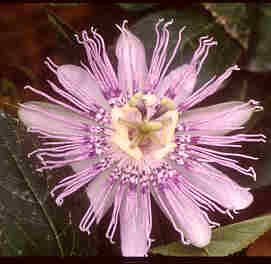
Plant Description
Caution & Interaction

Latin (botanical) name:
Passiflora incarnata
Common names: Passion Vine, Purple Passion Flower, Granadilla, Maracoc, Maypops
Plant Description: Passion Flower is indigenous in Virginia, and from the southeast United States to Argentina and Brazil. It is so named because of the finely-cut corona in the center of the blossoms to the Crown of Thorns. It is a woody, hairy, climbing vine whose stems climb by means of axillary tendrils. The stems can be anywhere from three to 10 feet long. Passiflora incarnata has a perennial root, and alternate, serrate leaves that are 3-5 lobed. The flowers, which bloom from May to July, are solitary, axillary, and from white to yellowish with a purple, pink or blue calyx crown. They are also very sweetly aromatic. The fruit of Passion Flower is about the size of a chicken egg, orange-colored, edible, and contains many seeds. These are often called maypops, granadilla, or water lemon. When dried, the fruit becomes shrivelled and greenish yellow, and the yellow pulp inside is sweet and edible.
Medicinal Properties &Uses: The active principle in Passion Flower has been called Passiflorine. It is somewhat similar to morphine. This naturally grown medicinal herb has been approved by the German Commission E for the treatment of insomnia and nervousness. The complex activity of the Passion Flower on the central nervous system shows it depresses the motor side of the spinal cord, slightly reducing arterial pressure and increasing the rate of respiration. It's tranquilizing effect has been found to be different from that of most sedatives such as sleeping pills; it is non-addictive. Due to the sedative nature of Passion Flower, it is helpful in the treatment of nervous disorders or gastrointestinal complaints brought about by mervousness. It has an antispasmodic effect on the body's smooth muscles, including the digestive system, so it promotes digestion and reduces spasms such as those related to Parkinson's disease, seizures and hysteria. It is effective in the relief of nerve pain due to neuralgia and shingles. Passion Flower has been known to help patients with epilepsy, neuralgia, and dysmenorrhoea.
Dosage: 30-60 drops in water or juice, 2-3 times daily or as needed. Shake well before using.
Cautions & Interactions: Keep out of reach of children.
Efficacy Studies & Other Clinical Data:
Disclaimer (U.S. Only): These statements have not been evaluated by the FDA. These products are not intended to diagnose, cure, treat, or prevent any disease.
Common names: Passion Vine, Purple Passion Flower, Granadilla, Maracoc, Maypops
Plant Description: Passion Flower is indigenous in Virginia, and from the southeast United States to Argentina and Brazil. It is so named because of the finely-cut corona in the center of the blossoms to the Crown of Thorns. It is a woody, hairy, climbing vine whose stems climb by means of axillary tendrils. The stems can be anywhere from three to 10 feet long. Passiflora incarnata has a perennial root, and alternate, serrate leaves that are 3-5 lobed. The flowers, which bloom from May to July, are solitary, axillary, and from white to yellowish with a purple, pink or blue calyx crown. They are also very sweetly aromatic. The fruit of Passion Flower is about the size of a chicken egg, orange-colored, edible, and contains many seeds. These are often called maypops, granadilla, or water lemon. When dried, the fruit becomes shrivelled and greenish yellow, and the yellow pulp inside is sweet and edible.
Medicinal Properties &Uses: The active principle in Passion Flower has been called Passiflorine. It is somewhat similar to morphine. This naturally grown medicinal herb has been approved by the German Commission E for the treatment of insomnia and nervousness. The complex activity of the Passion Flower on the central nervous system shows it depresses the motor side of the spinal cord, slightly reducing arterial pressure and increasing the rate of respiration. It's tranquilizing effect has been found to be different from that of most sedatives such as sleeping pills; it is non-addictive. Due to the sedative nature of Passion Flower, it is helpful in the treatment of nervous disorders or gastrointestinal complaints brought about by mervousness. It has an antispasmodic effect on the body's smooth muscles, including the digestive system, so it promotes digestion and reduces spasms such as those related to Parkinson's disease, seizures and hysteria. It is effective in the relief of nerve pain due to neuralgia and shingles. Passion Flower has been known to help patients with epilepsy, neuralgia, and dysmenorrhoea.
Dosage: 30-60 drops in water or juice, 2-3 times daily or as needed. Shake well before using.
Cautions & Interactions: Keep out of reach of children.
Efficacy Studies & Other Clinical Data:
- Health Quest - Passion Flower
- Holistic-Online - Passion Flower
- HerbMed - Passion Flower Clinical Trials
Disclaimer (U.S. Only): These statements have not been evaluated by the FDA. These products are not intended to diagnose, cure, treat, or prevent any disease.